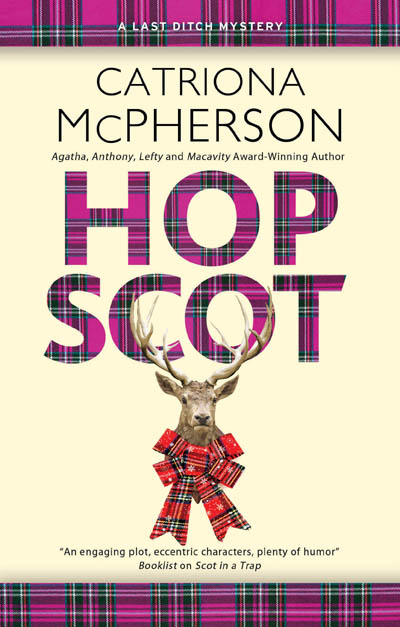From the Booking Desk:
It’s a bit of a tradition to have the one-and-only Catriona McPherson stop by for a guest post with each of her new releases. This time out, the new Last Ditch Mystery is Christmas-themed, so it will be no surprise to anyone that Catriona is here to discuss the different ways the holiday is celebrated–and just where do those traditions originate?
Snakes on a Tree
(and other Christmas Oddnesses)
I love Christmas. I love the lists, the pressure over last posting dates (shipping dates?), the hints dropped and the hints picked up about presents, I love writing cards and receiving them, I love decorating the house and filling it with food, so HOP SCOT, my Christmas-time entry in the Last Ditch Motel series, was a treat to write. I’m hoping it’ll be a treat to read too. By the way, HOP SCOT as a title is because Lexy and her crew “hop” over to Scotland for the holidays.

Someone from either my agent’s office or my publisher’s came up with the line “Lexy’s swapping cinnamon lattes for boiled Brussels sprouts” to sum up the switch from the US to the UK. (Thank you, whoever you are!) and it encapsulates Christmas in the two places quite nicely. Cinnamon isn’t nearly as ubiquitous there as it is here in December, but sprouts are iconic. You get Christmas cards with sprouts on, and there are cracker jokes (see below) about them. The late and much missed Victoria Wood used over-cooked sprouts as the punchline in one of her best comic songs, neatly combining both the central position of the sprout in British Christmas cooking and the likelihood of British cooks boiling vegetables to snottery mush all-year-round.
It never struck me as odd, till I came to a place where Brussels sprouts have no more to do with Christmas than broccoli and Easter, cabbage and Whitsun, kohlrabi and the feast of St Eusabius. (Why, yes I did just have to look that up. I had to double-check how to spell kohlrabi too.)

What did strike me as odd was the way people in America laughed automatically at the mention of fruitcake. (And you get cards with fruitcake jokes on them too, right?) What’s funny about delicious, traditional, rich, boozy, gorgeous cake?
Not to worry. For one thing, all the more for me. For another, no Christmas tradition makes sense if you think about it too long. And, if you try to make sense of it, you might end up wishing you hadn’t.
Did you know, for instance, that the tinsel we hang on our Christmas trees is supposed to represent the snake in the Garden of Eden? Or that the baubles are the apples the snake enticed Adam and Eve to eat? I don’t get it, but I believe it because Sandi Toksvig said it on QI. That’s not where I heard the theory that candy canes are Js for “Jesus”, though, and I’m not sure I buy that one, despite the fact that it makes a ton more sense. Who among us hasn’t had birthday decorations in the shape of our initials?

Mind you, the shape of the candy cane isn’t the feature that puzzles me most. It’s the flavour I find mystifying. Why should Christmas be minty? If anyone knows, please let on. (While we’re on the subject, why – at a time of feasting – should chocolate come in such mean, skinny little shards that it’s literally called “bark”? No clue.) Also, why do British people pull crackers at Christmas dinner? Not a scooby-doo. Again, it didn’t seem strange until I moved over here and realised they’re not universal. Indeed, that wee tiny bit of gunpowder that makes them crack is why they’re the most confiscated items at Heathrow’s international terminal in December, as relatives try to bring them over on visits. (The rest of the year, it’s Marmite.)
US Britbox watchers must surely wonder why all the characters on all the dramas and comedies spend the Christmas specials wearing paper hats. It’s because the paper hat is one of the things that bursts out of a pulled cracker, along with a prize and a joke. Ah, the cracker joke! They are terrible. They make dad jokes look like fodder for the White House Correspondents’ dinner. Why there can’t be good jokes in crackers is a seasonal puzzle no one has ever solved.

And maybe it should stay that way, because I can confirm that we solve puzzling Christmas traditions at our peril. For example, the meanings associated with holly, ivy and mistletoe. (Readers of a delicate disposition might want to skip the rest of this paragraph.) We all know that greenery is brought inside the house as a defiance of the dead time of the northern winter, right? I always thought that evergreen plants like pines and ivy are a focus of a belief that life goes on. And that mistletoe – seemingly miraculous – suggested the cold earth would not kill all living things. Man, I hope so. Because while I was researching HOP SCOT, I came across the alternative theory that the ivy represents the “twining” needed to produce new life; the holly berries are drops of menstrual blood; and the little white berries of the mistletoe are . . . need I go on?
On the one hand, as a Celt, I know that “fertility rituals” are the answer for why we do most ceremonial things we do in the calendar but, on the other hand, the rest of the old pagan Yuletide rituals are about that defiance of mid-winter scarcity. Food running out? Have a feast! Long time till spring? Cook up everything you’ve got in one massive pie and scoff the lot!

That’s why I’ve never had a problem with excess at this time of year – it’s the spirit of Christmas in the post-industrial-revolution era, where instead of cracking open your own stores of dried fruits to make the cake, you shop for them. The scene I enjoyed writing more than any other in HOPS SCOT was Lexy, her mum, Noleen and a toddler going to “the big Tesco” the day before Christmas Eve to lay the food and booze in.
If you’re going to be shopping for a Christmas feast later this month, I hope it goes more smoothly. If you’re having Chinese food and seeing a film, may your spring rolls be crisp and your view unobstructed. If you’re working on the 25th of December, may you have a quiet shift with big tips. Happy winter, one and all!

Catriona McPherson (she/her) was born in Scotland and immigrated to the US in 2010. She writes preposterous 1930s private detective stories, realistic 1940s amateur sleuth stories, and contemporary psychological standalones. These are all set in Scotland with a lot of Scottish weather. She also writes modern comedies about the Last Ditch Motel in a “fictional” college town in Northern California. HOP SCOT is number six in the series. Catriona’s books have won or been shortlisted for the Edgar, the Anthony, the Agatha, the Lefty, the Macavity, the Mary Higgins Clark award and the UK Ellery Queen Dagger. She is a proud lifetime member and former national president of Sisters in Crime. www.catrionamcpherson.com
